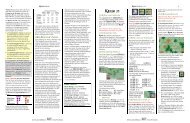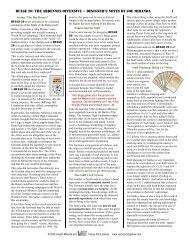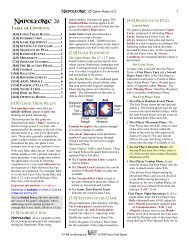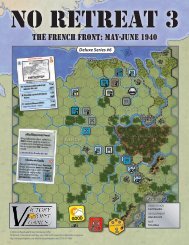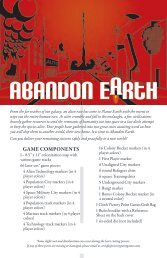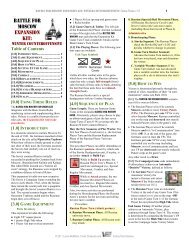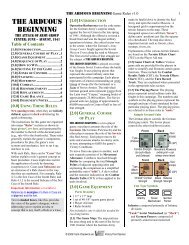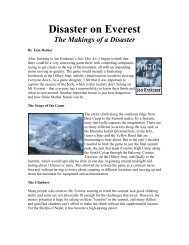Rules booklet - Victory Point Games
Rules booklet - Victory Point Games
Rules booklet - Victory Point Games
- No tags were found...
You also want an ePaper? Increase the reach of your titles
YUMPU automatically turns print PDFs into web optimized ePapers that Google loves.
Napoleonic 20 Standard Game <strong>Rules</strong> v3.0 3The Second Player Turn6. Repeat Phases 1 through 5, reversing theroles of the First and Second Players. Ifit is a Night Turn, afterward, reshuffleall the Random Event cards to form anew Draw Pile.Sudden Death Turns7. Certain Game Turns, indicated on theGame Turn Track by a red die-face,present the possibility for an earlyconclusion to the Battle. At the end ofthese Turns, the Second Player rolls adie and, if the result is less than orequal to (≤) the number shown on thedie-face, the game ends immediately andthe winner is determined. If the die rollis greater than the number shown, playcontinues on to the next Game Turn.[5.0] RANDOM EVENTSGeneral RuleRandom events are the imponderables ofwar-affecting campaigns.At the beginning of eachPlayer Turn, the PhasingPlayer reveals the topRandom Event card fromthe Draw Pile and immediatelyapplies that side’sevent (only, when there aretwo different events on the same card).When there are two evens on a card, thetop (blue-shaded) event is the FrenchPlayer’s and the bottom (non-blue shaded)event is the Anti-French Player’s.ProcedureIn addition to specific event instructions,reshuffle the deck at the end of each NightGame Turn. Unless otherwise specified onthe event itself, a specific event can occurmultiple times per game.[6.0] MOVEMENTGeneral RuleDuring your Movement Phase, you maymove as many or as few of your units asyou desire. You can move units in anydirection or combination of directions.ProcedureMove units one at a time, tracing a path ofcontiguous spaces along the map. As eachunit enters a space (called a “hex”), theunit pays one or more Movement <strong>Point</strong>sfrom its Movement Allowance to do so.Restrictions and Prohibitions[6.1] Strict Sequence: Movement nevertakes place out of sequence. You can onlyvoluntarily move your units during yourown (i.e., your ‘friendly’) Movement orReaction Phases (see 8.0 for the latter).[6.2] Speed Limit: A unit cannot exceedits Movement Allowance during a friendlyMovement Phase, with the exception thata unit can always move 1 hex per friendlyMovement Phase (as long as it is not intoprohibited terrain or across a prohibitedhexside), even if it does not have sufficientMovement <strong>Point</strong>s to pay the entire cost toenter that hex. A unit can expend all, someor none of its Movement <strong>Point</strong>s during itsfriendly Movement Phase. Unused Movement<strong>Point</strong>s do not accumulate from Turnto Turn, nor are they transferable from unitto unit. Unused Movement <strong>Point</strong>s are lost.[6.3] Enemies: A friendly unit cannotenter a hex containing an enemy unit.[6.4] No ‘Take Backs:’ All movement isfinal once a player’s hand is withdrawnfrom the unit he is moving. Players maynot change their minds and retrace a unit’smovement after releasing it.Strictly enforce this Rule!During these campaigns,units often went in thewrong direction at decisivemoments with disastrous results.Terrain EffectsNormally, units pay one (1) Movement<strong>Point</strong> to enter each hex, regardless of itsterrain type. However, the following Casesapply to define this further:© 1999 Joe Miranda and © 2013 <strong>Victory</strong> <strong>Point</strong> <strong>Games</strong>



